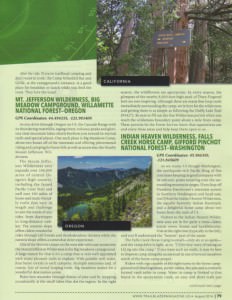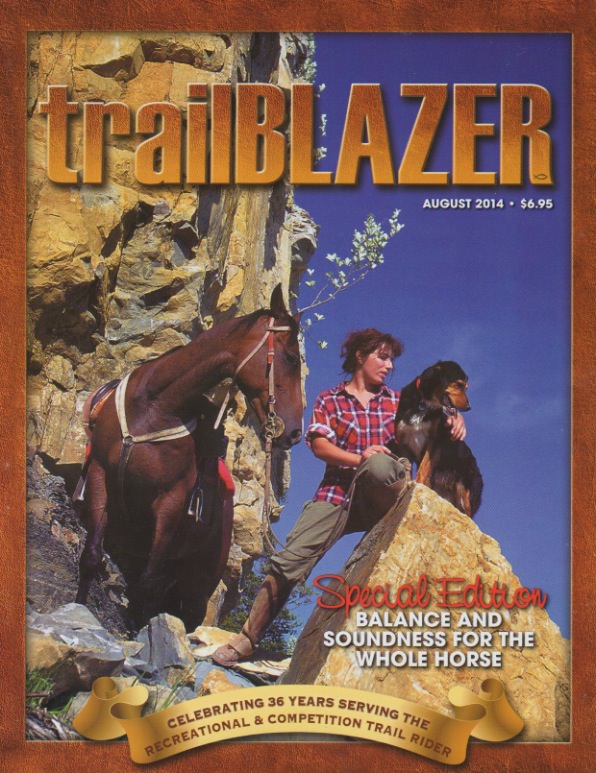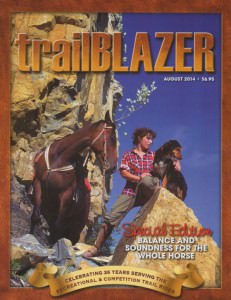Wilderness areas – August 2014 Wilderness Potpourri
What a Ride! Following Interstate 5 Through California, Oregon & Washington State Wilderness Areas
There are as many ways to tackle a wilderness trail ride as there are wilderness areas. This month we’ve narrowed our trips down to focus on areas easily accessible from Interstate 5. If you’re adventurous enough gas-up and try all of these areas for a massive summer riding road trip. If don’t have that much vacation time to burn. Pick one area this summer and put the others on next year’s calendar. Both ways each trip and trail riding adventure will be memorable.
As we go from wilderness to wilderness we’ll follow “the five” as it stretches 1,381 miles from Mexico to Canada, Interstate 5 is the main north south route for the west coast, passing through the length of California, Oregon, and Washington as it connects most of the major west coast cities.
California, Sespe Wilderness, Reyes Creek Campground, Los Padres National Forest
Trailhead Coordinates: 34.677644, -119.309135
First let’s explore a few of the 219,700 acres of the Sespe Wilderness in Southern California. With cliffs and fabulous sandstone formations rising hundreds of feet above the wilderness’s namesake creek this is an impressive area to visit. Not only is the area rich in geologic history it also offers the attentive rider an abundance of human history in the fading petroglyphs left by visitors from times long past. Riders with sharp eyes pointed up may glimpse a rare California condor soaring high overhead as it flies over and through the Sespe Condor Sanctuary that is also located within this remarkable area.
Getting into this amazing wilderness is as easy as heading west from Interstate 5 and heading up highway 33, which passes through the middle of the Los Padres National Forest; home of the Sespe Wilderness. Less than two miles off Hwy 33 is the Reyes Creek Campground and our starting point for excursions into the boulder swept hillsides of the Sespe. The camp, tucked under shady oaks and cottonwood trees, offers two corrals and a vault toilet. Although Reyes Creek is immediately adjacent to the camp it’s best to bring your own water for both you and your stock.
Getting from the campground to the wilderness is a quick ride a few feet to the Gene Marshall-Piedra Blanca National Recreation Trail trailhead. This 18 mile trail winds its way through the wilderness and even has backcountry campsites scattered along its length for those looking to venture beyond trailhead camping.
SIDEBAR – After the Ride: If you’re trailhead camping and don’t want to cook, the Camp Scheidick Bar and Grille, at campground’s entrance, is a good place for breakfast or lunch while you feed the trout. They love the toast!
 Oregon, Mt. Jefferson Wilderness, Big Meadow Campground, Willamette National Forest
Oregon, Mt. Jefferson Wilderness, Big Meadow Campground, Willamette National Forest
Trailhead Coordinates: 44.494335, -121.983400
As you drive through Oregon on I-5 the Cascade Range with its thundering waterfalls, raging rivers, volcanic peaks and glorious clear mountain lakes clearly beckons you towards its myriad of trails and special places as you cruise past at highway speed. One such special place is the Big Meadows Camp, about two hours off of the interstate and offering phenomenal riding and camping for horse folk such as you and I as well as access into the Nearby Mount Jefferson Wilderness.
The Mount Jefferson Wilderness area expands over 104 thousand acres of central Oregon’s high country including the famed Pacific Crest Trail and well over a hundred miles of horse and mule friendly trails that vary in length and challenge to suit the wants of any rider from day tripper to long distance trekker. The western slopes offer riders wonderful rides through tall forests and rhododendron thickets while the eastern slope offers a somewhat drier experience.
One of my favorite camps on the west side with easy access into the Mount Jefferson Wilderness is the Big Meadows campground. A large reason for that is a camp that is very well appointed with many pleasant trails to explore. With potable well water, four horse corrals in each campsite, multiple restrooms and of course, lots of varied looping trails. Big Meadows makes for a wonderful destination point.
Rides here meander through forests of pine and fir, stopping occasionally at the small lakes that dot the region. In the right season the wildflowers are spectacular. In every season the glimpses of the nearby 8,000 feet high peak of Three Fingered Jack are awe-inspiring. Although there are many fine loop trails immediately surrounding the camp we’re here for the wilderness and getting there is as simple as following the Duffy Lake Trail (#3427). Be sure to fill out the free Wilderness permit when you reach the wilderness boundary point about a mile from camp. These permits let the Forest Service know that equestrians use and enjoy these areas and help keep them open to us.
 Washington, Indian Heaven Wilderness, Falls Creek Horse Camp, Gifford Pinchot National Forest
Washington, Indian Heaven Wilderness, Falls Creek Horse Camp, Gifford Pinchot National Forest
Trailhead Coordinates: 45.966310, -121.845609
As we cruise Interstate 5 though Washington the Pacific Ring of Fire continues with us keeping us good company with it’s volcanic peaks towering over the surrounding mountain ranges. If you hop off of President Eisenhower’s interstate system in Southern Washington and head east you’ll find the Indian Heaven Wilderness, the equally heavenly Indian Racetrack, and a delightful horse camp about two hours from the rush of I-5.
Visitors to the Indian Heaven Wilderness area are in for quite a treat. Lakes, scenic views, forests and huckleberries – visit at the right time and you’ll understand the “heaven” part of the name.
The Falls Creek Horse Camp is small, only six or so spots and the camp drive is tight – tight as in, “I’d be very wary of taking a LQ rig into the camp.” If you have such an outfit, it may be best to disperse camp along the access road in one of several meadows north of the horse camp proper.
Riders with rigs capable of the tight turns in the horse campground will find highlines, picnic tables, fire pits, and a centrally located vault toilet in camp. Water in camp is limited to that found in the eponymous creek, an easy and short walk just south of camp.
Once you’ve arrived and settled in, it’s time to ride, and the riding is good. The Indian Racetrack Trail (#171) is located on the opposite side of Forest Service Road 65 just north of the horse camp entrance. This trail will take you into the Indian Heaven Wilderness (remember to sign in) and proceeds through a rather rough and rocky trail to a broad meadow and the Indian Racetrack.
The Indian Heaven Wilderness, and particularly the Indian Racetrack, has some great history behind it. For centuries, local native tribes would gather here each summer to partake of the area’s bounty of deer, fish and huckleberries. When not hunting, fishing, or berry picking, they raced their horses so frequently and with such vigor that the track drummed into the dirt still exists today as a bare depression that runs straight as an arrow for about a quarter of a mile. This is the Indian Racetrack. When we visited, we thundered down the racetrack ourselves…at a trot.
SIDEBAR: A notable viewpoint quite near Indian Racetrack is Red Mountain. From the top of Red Mountain you’ll have a wonderful (if not windblown) vista of many of the volcanoes forming the Pacific ring of fire. To the north, Mounts Baker and Rainier are clearly visible; to the northwest is Mount St. Helen’s broken cone, which is mirrored to the northeast by Mount Adams. A glance to the south will bring Mount Hood as well as California’s Mount Shasta in view.
I hope that you’ve enjoyed this month’s visits to three more heavenly wilderness areas. As always for more information on these and many more horse riding and camping areas in North America visit www.TrailMeister.com. Until next month, when we explore more wilderness topics, ride safe and ride often!



